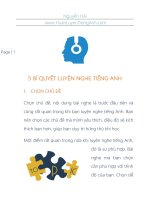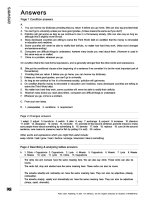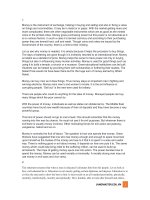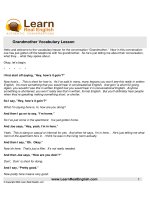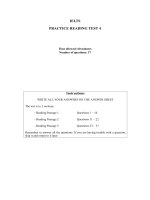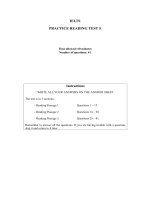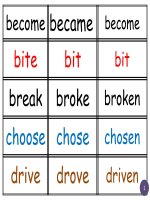Career paths nursing SB kho tài liệu học tiếng anh
Bạn đang xem bản rút gọn của tài liệu. Xem và tải ngay bản đầy đủ của tài liệu tại đây (22.5 MB, 120 trang )
Published by Express Publishing
liberty House, Greenham Business Park, Newbury,
Berkshire RG19 6HW
Tel.' (0044) 1635 817 363
Fax, (0044) 1635 817463
e-mail:
@ Express Publishing, 2011
Design © Express Publishing, 2011
Color Illustrations: Alex @ Express Publishing, 2011
First published 2011
Made in EU
All rights reserved. No part of this publication may be reproduced, stored in a retrieval system, or
transmitted in any form. or by any means, electronic, photocopying, or otherwise, without the prior
written permission of the publishers.
This book is not meant to be changed in any way.
ISBN 978-0-8sm-838-3
Acknowledgements
Authors' Acknowledgements
We would like to thank all the staff at Express Publishing who have contributed their skills to producing
ttVs book. Thanks for their support and patience are due in particular to: Alex Newton (Editor in Chief);
$ean TOOd (senior editor); Steve Miller (editorial assistant); Richard White (senior production controller);
the Express design team; Sweetspol (recording producers). We would also like 10 thank those institutions
and teachers who piloted the manuscript, and whose comments and feedback were invaluable in the
production of the book.
Every effort has been made to trace all the copyright holders. If any have been inadvertently
overlooked, the publishers will be pleased to make the necessary arrangements at the first
opportu nity.
Virginia Evans
Kori Salcido - RN.
~~
Express Publishing
Unit 1 - Hospital staff .......... . .. . ..... . . . ........ . . .... . .... . .............. 4
Unit 2 - Hospital departments ......... . . . . ............................ . .... . 6
Unit 3 - Rooms and equipment ................. . .. . .. . .. .. ........ .. . .. ..... 8
Unit 4 - The body .............. .. .. . ... . . . ...... ............ .... ............. 10
Unit 5 - Blood ................ . .. . . . ... . .. .. . . .. . .. . ... . ............... . ...... 12
Unit 6 - The Circulatory system .. . .. . .. . . . ..... .. . .. ........................ 14
Unit 7 - The Respiratory system ..... . ................. . . . . .. . .. . .. . . .
16
Unit 8 - The Digestive system ......... . .. . ....... . .......................... 18
Unit 9 - Physical assessment
............. . ..... . ..... . ........... ... 20
Unit 10 - Recognizing symptoms .....• . . • . .. .. . . .. • ........................ 22
Unit 11 - Pain ................... . .. . ................... . ..... . .. . .. . ... . ...... 24
Unit 12 - Medication ............. .
. .. .. . .. .. ...... . ..•............•....... 26
Unit 13 - Licensed practical nurse ...
Unit 14 - Registered nurse
Unit 15 - Nurse practitioner
.
. . .
. .. . .. .. . ...... ...... . . .... . . ..... 28
.... . . . . . .
. .. . . . .
..~
. .. ... .. . . . . . .
. . . .. .. . .. . . . . . . . . . .. . .. .. . .. . . .
.32
Glossary ...... . ..................... . . . .. .. ....... . .......................... 34
Get ready!
o Before you read the passage,
Read the hospital directory. Then, choose
the correct answers.
talk about these questions.
1
1 What jobs do people have in hospitals?
2 Which employees do nurses work with
most often?
need to
•.
..'
MERCY HEART HOSPITAL
DIRECTORY
I
FIRST FLOOR
Robert Gibbons
Receptionist
Dr. Terry David
Pediatrician
See for: Children's Health:
See for: Visitor
Information: Main Lobby
Rm.200
Dr. Frank Fabrizzio
THIRD FLOOR
Dr. James Lottner
Anesthesiologist
See for: Surgery Pain
i
and Preparation: Rm. 312
Radiologist
See for: X-rays, MAl
scans: Rm. 113
Usa Kirby
Lab Technic ian
See for: Analysis. Test
Results.: Rm. 125
Pr_
Dr. Stacey Waiters
Chief Surgeon
See for: Surgical
Procedures: Rm. 323
Susan Devlin
Pharmacist
See too
PdI-t.pFm1ZJ
""-!l
SECOND FLOOR
Or. Leslie Gupta
Cardiologist
See for: Heart Disease,
Heart Surgery: Rm. 231
4
FOURTH FLOOR
Dr. Jared Cho
General Practitioner
See for: General M~;;c;I'.' !
What is the purpose of this document?
A locating hospital departments
B listing available staff positions
C helping people find hospital staff
D providing employee's contact information
2 Who is best qualified to examine a sick five·
year·ok!?
A a receptionist
C a pharmacist
B a lab technician
0 a pediatrician
3 What can you infer about patients being
prepared for heart surgery?
A They see the general surgeon last.
B They are treated by Dr. Gupta.
C They have their operations on the first floor.
D They must visit doctors on multiple floors.
Vocabulary
@ Match the
words (1-7) with the definitions
(A-G).
1 _lab technician
2 _surgeon
3 _ anesthesiologist
5 _ radiologist
6 _ receptionist
7 _ cardiologist
4 _ pharmacist
A a person who prepares drugs and medicine
B a person who uses imaging technology
Rm.403
C a heart specialist
Dr. Regina Beverly
Obstetrician
See for: Pregnancy:
D a person who analyzes samples
Rm. 408
E a person who cuts open the body in operations
F a person who prevents patients from feeling pain
G a person who welcomes visitors and answers
phones
o Fill in the blanks with the correct words
and phrases from the word bank.
~
pediatrician
BANK
general practitioner
obstetrician
1 A(n)
observes and treats pregnant
women until they give birth.
Speaking
o based
With a partner, act out the roles below
on Task 7. Then, switch roles.
USE LANGUAGE SUCH AS,
I'm
a new nurse here.
I have these ...
He's on the _. floor somewhere.
2 Parents often take a long time to choose their
childs _ __
3 For small problems like a cold, see a(n)
_ _ _ instead of a specialist.
0 "
Listen to and read the hospital
directory again. Where can you pick up
your medicine from?
Listening
0"
Listen to a conversation between a
nurse and an obstetrician. Mark the
following statements as true (T) or false (F~
Student A: You want to find someone who
works in the hospital. Ask Student B questions
to find out:
•
floor number
•
room number
•
where to find additional help
Student B: You are an employee at the
hospital. Answer Student A's questions.
1 _ The man needs to look at x-rays.
Writing
2 _ The radiologist works on the third floor.
CD Use the conversation from Task 8 to fill
3 _ The woman directs the man to the
receptionist.
out some entries in a hospital directory.
fj" Listen again and complete the
conversation.
Nurse: Excuse me, Dr. Beverly? Hi. I'm
Mark. I'm a new 1
here.
Obstetrician: Hey, Mark. What can I do for you?
Nurse: I have these 2 ___ for Or. Cho's
patient. He wants Or. Fabf"izzio to
take a look at them.
Obstetrician: The 3 _ _--'? He's on the first floor
somewhere.
Hospital
Directory
Name: ____________
Job Title: _ __ _ _ _ _ __ _
Nurse: Do you happen to know the actual
4
Job Duties: _ _ __ _ _ _ _ __
?
Obstetrician: No, but the 5
in the lobby wilt
Nurse: Okay. This 6
is so confusing!
Obstetrician: I know the feeling. You'll get used to it.
Name: _ ___________
Job Title: _ _ _ _ __ _ _ __
Job Duties: _ _ _ _ _ _ _ _ __
5
& Read the flyer. Then, mark the following statements as
true (T) or false (F).
1 _ The hospital is beginning construction to repair damages.
A
Construction Notice
St. Sebastian's Hospital wants to give its
patients the best care possible. In order to
do this, we need to update our facilities
from time to time. As a result, we are
starting some construction projects today.
Some departments are temporarily moving
during construction. The cardiology
department is now in the basement across
from the radiology and pathology
departments. Obst etrics is on the second
floor next to pediatrics.
.
Access to other departments is limited.
The entrance to orthopedics is now
through the dermatology department. The
surgery wing of the hospital is only
accessible through the lobby elevators.
The emergency room and the pharmacy
are unaffected.
2 _ The radiology department is on the same floor as the
cardiology department.
3 _ Patients have to go through the pathology department to
get to orthopedics.
Vocabulary
8
Write a word that is similar in meaning to the
underlined part.
1
2 The patient needs medicine so he goes to the place where
pharmacists distribute pharmaceutical drugs. p __ r __ c _
3 Employees in the department that studies and diagnoses
diseases must wear gloves and goggles. _ a __ 0 I 0 __
4 Doctors in a medical field that uses instruments to operate
on patients need very steady hands. s __ g __ Y
5 Sau! works on an ambulance, so he sees plenty of situations
in which someone's life is in danger. __ e _ g __ c __ s
o Check (J') the sentence that uses the underlined part
correctly.
1
2
,
3
Get ready!
o Before you read the passage,
t alk about these questions.
1 What services do patients get in
different hospital departments?
2 Which hospital departments
need nurses the most?
6
Andrews son is sick, so he takes him to the department that
deals with the care of children. __ d __ t __ c _
4
S
_ A
Aalph is at the cardiology department because his
heart is beating abnormally.
_ B
Doctors in the pathology department respond to
emergency situations.
_ A
Francesca is going to the surgery department to pick
up her prescription.
_ B
Wendy has a broken Jeg so she's going to the
orthopedics department.
_ A
_ B
The pregnant woman is in the obstetrics department.
Doctors who work in the pathology department only
care for children.
_ A
_ B
Doctors usually periorm surgery in the pharmacy.
_A
The pedjatrics department is where doctors inspect
organs to diagnose diseases.
_ B
Joe is at the dermatology department to get his rash
examined.
Gregory takes x-rays in the radiology department.
0"
Listen and read the flyer again. Why
have been departments moved temporarily?
Speaking
(;) With a partner, act out the roles below
based on Task 7. Then, switch roles.
Listening
o nurse
" Listen
to a conversation between a
and a patient. Choose the correct
USE LANGUAGE SUCH AS,
This is the ._ department, isn't it?
answers.
So where can I find ...
1 What is the main idea of the conversation?
Do you need directions to get there?
A why the patient missed his appointment
B why the hospital is under construction
C how to find a specific hospital department
D how to get to the ground floor of the hospital
Student A: You are a patient. And you are
going to an appointment with your doctor. Talk
to Student B about:
•
•
2 What does the nurse tell the man to do?
A go to the basement
•
B reschedule his appointment
where the department you need is located
why you need to go there
how to find the department
C ask a receptionist for directions
Student B: You are a nurse. Answer Student
A's questions.
o visit the radiology department
8"
Listen again and complete the
conversation.
o
Patient: Excuse me, nurse? This is the
cardiology 1 _ _ ~ isn't it?
Nurse: Well, usually it is. But the hospital is under
2
right now, so some
Writing
o Use the conversation from Task 8 to fill out
a note that helps patients find a department.
departments are in different plac es.
Patient: Oh, So where can I find 3
?
Nurse: Ifs in the 4
now. Ac ross from
radiology and pathology.
Patient: Oh good. I don't want to miss my
5
with my cardiologist.
The
__ _- - - - department has
moved to
Nurse: Do you need directions to get there?
Patient: I think so.
because of
Nurse: Take the 6 _ __ down to the
basement level. Cardiology is to the right.
TO get there:
_
It is _ _ - -- -- - the
_ _ _ __ _ _- department.
. e'.
SOrry tor the inconvenlenc
7
•
( syringe
j
Get ready!
o Before you read the passage, talk about
these questions.
1 What equipment do you find in a hospital room?
2 What are the different kinds of equipment
used for?
•
lONGMAN HOSPITAL
ROOM CHECKLIST
Be sure that the following items are addressed before each
patient is admitted. Sign and date after preparing the room.
Check that a wheelchair is present
Test call button to ensure proper
functioning
Reading
f)
Read the checklist at Longman Hospital.
Then, mark the following statements as
true (T) or false (F).
1 _ Nurses must make sure the call button wOO
half full.
3 _ Nurses discard used syringes in biohazard
waste containers.
Make sure an oxygen tank is present and at
least 80% full
Vocabulary
Check that the alternating pressure
mattress is working properly
~ Match the words (1-5) with the definitions
(A·E).
Discard used hospital gowns and restock
bedside table with new ones
1 _ biohazard waste container
2 _ oxygen tank
Make sure drawers are stocked with latex
gloves and gauze
3 _ syringe
Discard used syringes in sharps cont"in'"
and restock drawer with new syringes
5 _ latex gloves
Empty and clean biohazard waste
container
A a container shaped like a tube that is used to
draw or push liquid out of or into something
Room Prepared by: _ _ _ _ _ __
D818: _ __ _ _ __
4 _ alternating pressure mattress
B a mattress that helps to prevent sores by keeping
pressure off of certain areas of the body
C
a special container that stores harmful
biological substances
o gloves made of a flexible material that doctors
often wear
E a container that holds pure oxygen
8
o the
Write a word that is similar in meaning to
underlined part.
1 The nurse uses a syringe and then puts it into
a spec jal container that stores sharp hospital
objects. s __ r __
c __ t __ n_r
Speaking
fj) With a partner, act out the roles below
based on Task 7. Then, switch roles.
USE LANGUAGE SUCH AS,
2 Amy is in the hospital. She has on a hospital
garment that a patient wears. g _ w _
Can you help me with something?
3 Bob needs a nurse. He summons her using the
button jn a hospital room that a patient presses.
Anything else?
c __ 1
Where are those?
b __ t __
4 Ellen can't walk. She uses a chair wjth wheels
to move around. _h __ l_h_i_
5 Jack's arm is bleeding. The nurse wraps il in Si
thin cloth used to coyer jnjurjes. _ a _ z _
0"
Listen and read the checklist again,
What must nurses make sure drawers are
stocked with?
Listening
Student A: You are a new nurse. You are
learning how to do your job. Ask Student B
questions about:
•
•
•
clean gowns
refilling oxygen tank
sharps container
Student B: You are an experienced nurse at
the hospital. Answer Student A's questions.
0"
Listen to a conversation between two
nurses. Mark the following statements as
true (T) or false (F),
1 _ The man is having trouble finding some
equipment.
CD Use the conversation from Task 8 to fill out
the new nurse's notes,
2 _ The man can refill the oxygen tank in the
first floor closet.
3 _ The man should throwaway the full sharps
container.
n
wJob
Location of clean gowns:
fI"
Listen again and complete the
conversation.
Nurse 1: Becky. can you help me with
something?
Writing
o
Nurse 2: Sure! I know how hard it is 10 1 _ _
_ _ on your first day.
Where to refill oxygen tank:
Nurse 1: Room 415 needs some 2 _ _ _ _ ,
Where are those?
Nurse 2: In the first floor closet.
Nurse 1: Great. Also, where can I refill an 3 _ _
tank?
What to do with sharps container:
Nurse 2: Don't refill them. Just get a replacement
tank on the 4 _ _ ftoor. Anything else?
Nurse 1: Yeah. The 5 _ _ container is full.
Should I dispose of it?
rse 2: Definitely. And 6 _ _ _ _ __
_ _ from room 102.
9
[SSING
New .,.....,
...
1. Approach the patient to assess the injury. Ask where
the pain is.
6
Read the treatment guide.
Then, choose the correct answe",.,
1 What is the point of this guide?
2. Check for a pulse in unresponsive patients. Place
your index and middle finger on the left wrist.
3. look around the patient's body for external
injuries. This includes swelling, bruises, and bleeding.
4. Feel around with your hands for bumps in the arms,
legs, and extremities. Bumps suggest an internal
injury like a broken bone.
A when to use first aid
B identifying a spinal injury
C treating patients with no pulse
D how to assess people's injuries
2 What do you do first when a patient is
unresponsive?
A elevate the legs
5. Elevate the legs above the heart in cases of leg
swelling or fainting.
6. Do NOT move patients with potential spinal injuries.
Keep the patient's head in place.
B check for a pulse
C keep the head in place
D search for broken bones
3 What can you infer about internal injuries?
7. Use first aid 10 treat any extemal injuries.
A They cause patients to collapse or faint.
B They require patients to keep their heads still.
C They are usually accompanied by external
injuries.
D They are not clearly identified in an initial
assessment.
Vocabulary
e Match the words (1-8) with the definitions
(A-H).
1 _spinal
2 _wrist
3 _arms
4 _internal
5
6
7
8
_hand
_external
_legs
_ extremities
A located on the outside of something
B the body parts located below the waist that
people stand on
o Sefore
you read the passage, talk about
these questions.
C the end of the arm that grabs and holds things
D relating to the bones in the back and neck
E parts of the body furthest from the center
1 What are the different parts of the body?
F the body parts extending from the shoulders
2 How does a nurse treat injuries to the body?
G located inside of something
H the body part that connects the hand to the arm
o Fill in the blanks with the correct words
from the word bank.
~
(;) With a partner, act out the roles below
based on Task 7. Then, switch roles.
BANK
bone
elevate
pulse
Speaking
head
USE LANGUAGE SUCH AS,
What seems to be wrong?
1 In cases of swelling, _ __ the legs above
the heart.
2 A patient with a neck injury should not move
his or her _ _ _
My leg really hurts.
There's a bump and some swelling.
3 Check for a _ __ in the unresponsive
patients.
Student A: You are a nurse. And you're
checking a patient. Talk to Student B about:
4 The longest and hardest ___ in the body is
in the thigh.
•
•
•
0"
Listen and read the treatment guide
again. How does a nurse assess new
patients?
checking for breaks
elevating the legs
other injuries
Student B: You are a patient. Think of injuries
and tell Student A what's wrong.
Listening
0"
Listen to a conversation between a
nurse and a patient. Mark the following
statements as true (T) or false (F).
1 _ The nurse finds a bump on the patient's leg.
Writing
(0 Use the conversation
from Task 8 to fill
out the report.
2 _ The patient has multiple injuries.
3 _ The patient's wrist is too painful to move.
og
Listen again and complete the
conversation.
Nurse: Hi, Mr. Aeynolds. What seems to be
wrong?
Patient: I fell down the stairs. My 1
hurts.
really
Nurse: I'm checking for a break. Tell me if it hurts,
when I touch your leg.
Patient: Okay ... Owl Right there.
Nurse: Yeah, there's a 2
swelling. I'm going to 3
Patient: My 4
and some
your legs.
hurt, too. Just above the
5 __
Nurse: Yes, there's a 6
sore to move?
Patient: No, I can move it. But
it hurts when I do.
forming. Is it too
Patient name: - - - - - - - - - - Cause 01 injury:
Vocabulary
8
Read the sentence pair. Choose where the words best
fit the blanks.
1 platelets/clots
When people are injured,
The
Get ready!
o Before you read the passage,
talk about these questions.
1 Why is donating blood important?
2 How can donating and receiving
fann to stop the bleeding.
circulating in my blood help me stop bleeding.
2 universal donorlbleeding
Sam is _ _ _ a lot. She might need to accept someone
else's blood!
Hannah is a ___ because she has Type 0 blood.
3 plasma/red blood cells
Brent always donates his ___ because the laboralOf)'
pays him for it.
Your
allow oxygen to circulate throughout your body_
blood be made safer?
Reading
f} Read the flyer. Then, mark the
following statements as true
(T) or false (F).
1 _ Universal donors have blood
that anyone is able to accept.
2 _ The blood bank needs Type
AB blood for medical
research.
3 _ Blood loss is prevented by
platelets.
12
o Match the words (1-5) with the definitions (A-E).
1 _ Type A
3 _ Type AB
2 _ Type B
4 _ Type 0
5 _ compatible
A having only the B antigen in its red blood cells
B having both the A and B antigens in its red blood cells
C having neither A nor B antigens in its red blood cells
o having only the A antigen in its red blood cells
E capable of working or existing with something else
o is"theListen
and read the flyer again. Which blood type
most important?
Speaking
Listening
at"
Listen to a conversation between a
nurse and a blood donor. Choose the
correct answers.
1 What is the conversation mostly about?
A the dangers of bleeding too much
B the best way to prepare for donating blood
o With
a partner, act out the roles below
based on Task 7. Then, switch roles.
USE LANGUAGE SUCH AS,
Is this your first time donating?
And I see on your fife that you have Type 0 blood?
So my blood is compatible with everyone?
C the impacts of being a universal donor
D the consequences of getting the wrong
blood type
2 The man can only accept
A Type A blood
B Type 0 blood
C Type B blood
0 Type AB blood
3 What can be inferred about the man?
Student A: You are a blood donor. And you
are discussing blood donation and blood type
with a nurse. Talk to Student B about:
•
•
•
how you feel
who can receive your blood
whose blood you can receive
A He has never received donated blood.
B He has donated blood many times before.
C He is comfortable with donating blood.
Student B: You are a nurse and you are
taking a blood donation from Student A
Answer Student A's questions
o He is donating blood for a family member.
0"
Listen again and complete the
conversation.
Nurse: Thanks for coming 10 the blood
drive Mr Fisher. Is this your first
time 1
?
Writing
CD Use the conversation from Task 8 to fill
out the nurse's notes about a patient who
donated blood.
Blood Donor: It is. I'm actually a little 2 _ _----'
Nurse: Don't worry. It doesn't hurt at all.
And I see on your file that you have
3
blood?
Blood Donor: Yes, that's right. Does it matter?
" Copilol Blood Bonk
Blood Donor Name:
Nurse: Actually, it's great news. You're a
4 _ _ _ _ __
Blood Donor: So my blood is compatible with
5
Blood Type:
?
Nurse: Exactty. Type A, B, AB-it doesn't
matter. But unfortunately, you can
6
only your own blood
Universal Donor? Y I N
Donated Before? YI N
type.
Blood Donor: Well, hopefully I'll never need to!
Palient Queslions/Concerns:
The circulatory system pumps
nutrients and oxygen around the
body. Blood lacking oxygen enters
the right atrium of the heart through
the vena cava. The heart pumps this
blood through a valve and into the
right ventricle. It travels through
pulmonary arteries to the lungs and
receives oxygen. It travels back to
the heart through pulmonary veins.
The heart pumps the blood out
through the aorta. It flows through
capillaries in the body and delivers
oxygen. The blood travels back
through veins and the cycle repeats.
But sometimes disruptions in the
cycle occur. The heart may not
pump blood effectively_ This is called
an arrhythmia.
vena cava
aorta
Get ready!
o Before you read the passage, talk about
these questions.
1 What does a person's circulatory system do?
2 What problems do people experience related
to their circulatory system?
Vocabulary
@ Match the
words (1-7) with the definitions
(A-G).
Reading
1 _ vena cava
f) Read the poster in a medical office about
2 _ atrium
the circ ulatory system. Then, fill in the
blanks with the correct words from the
word bank.
A a small tube that lets blood and tissue
exchange nutrients
B ·, NK
aorta
lungs
The ruman 1
circulatory
oxygen
atrium
system delivers nutrients to
parts of the body. Blood enters the heart's right
2
. It travels to the right ventricle. And then
rlto the 3
through pulmonary arteries. It
receIVes oxygen and travels back to the heart. The
heart pumps the blood out through the 4 _ __
The blood delivers 5
to the body.
1
3 _valve
4 _pulmonary
5 _artery
6 _capillary
7 _ ventricle
B one of the two upper chambers of the heart
C one of the two major veins that carries blood
to the heart
o relating to the lungs
E a tube that carries blood from the heart to the
body
F a structure in the heart that opens and closes
G a space in the heart that holds blood
() Check (.I ) the sentence that uses the underlined part
correctly.
Speaking
(l) With a partner, act out the
1 _ A Your b.Qart pumps blood and keeps you alive.
_ B
roles below based on Task 7.
Then, switch roles.
A capillary is a structure that opens and closes.
2 _ A Your ~ carry blood back to the heart.
_ B An atriImJ. is a tube in your lungs.
USE LANGUAGE SUCH AS,
I have your test results back.
What do they say?
3 _ A The aQ!1a sends blood from the heart to the rest of
Is there any treatment for this?
the body.
_ B
Your ~ carry blood back to the heart from the body.
Student A: You are a patient.
And you are receiving a medical
test. Ask Student B Questions to
find out:
4 _ A The vena cava lets blood and tissue exchange nutrients.
_ B An arrhythmia can make your heart beat abnormally.
0"
Listen and read the poster again. How is oxygen
distributed around the body?
Listening
o patient.
g Listen to a conversation between a nurse and a
Choose the correct answers.
•
test results
•
explanation of condition
•
treatment options
Student B: You are a nurse
conducting a medical test.
Answer Student A's questions.
1 What is the main idea of the dialogue?
A explaining a patient's condition
Writing
B checking the results of a treatment
o Use the conversation from
C testing a patient for a heart condition
o scheduling an appointment for treatment
Task 8 to fill out the test
results form.
2 What is wrong with the patient's heart?
A It has a small tear in it.
B It has a clog in the atria.
e It is not pumping blood fast enough.
Medical Test
Results
o Its valves are not functioning correctly.
0"
Listen again and complete the conversation.
Nurse: Good aftemoon, Fred. I have your 1 _ _ _ _ _ _.~.,",,-
~'
back.
Patient Name: _ _ _ __
Patient: What do they say?
Test Results: Detecting an _
Nurse: Well, we're detecting an 2 _ __
Patient: Oh. What exactly does that mean?
Seriousness: ______
Nurse: It means that your heart 3 _ _ _ aren't pumping
blood through the atria properly.
Patient: Is there any 4 _
Nurse: Yes. We're going to start you on medication and see
5
. Luckily, this form of
arrhythmia isn't too serious.
Patient: Well, that's 6
Treatment Plan: _ _ _ __
__ for this?
11
to hear.
15
•
•
•
Get ready!
o Before you read the passage, talk about these queellons.
1 What does the respiratOf)' system do?
2 What are some common problems with the respiratory
system?
SMOKING: KNOW THE RISKS
Your respiratory system is important.
Smoking can hurt the people around
The oxygen you need gets to the
you, too. Research suggests inhaling
lungs through the bronchial tubes.
Alveoli in the lungs give oxygen
passage into the bloodstream. tt also
removes toxic c arbon diox ide from
your body.
Smoking damages every part of this
process. Smoking can lead to
emphysema. This disease destroys
alveoli. This impairs their function,
makes breathing difficult and raises
carbon dioxide levels.
Smoking may also cause lung cancer.
The lungs' epithelial cells start growing
uncontrollably.
second-hand smoke is a leading
cause of asthma. Asthma sufferers'
bronchial tubes swell, making breathing
difficult.
Not smoking or quitting can decrease
your chances of developing these
diseases.
Reading
Vocabulary
f)
~ Match the words (1.7) with the definitions
Read the hospital poster. Then, choose
the correct answers.
1
What is the main idea of the poster?
1 _lung cancer
A steps to quitting smoking
2 _oxygen
B the illnesses that smoking causes
3 _ epithelial cell
4 _emphysema
C repairing the damage caused by smoking
o why people have difficulty quitting smoking
2 Which of the following adds gases to the blood?
5 _alveoli
6 _ bronchial tube
7 _lung
A a small part that makes up lining tissue
B the organ used to breathe
A lungs
C epithelial cells
C the sacs that bring oxygen into the bloodstream
B alveoli
o bronchial tubes
o the gas that people breathe in
3 What can you infer about emphysema?
A It is caused by second-hand smoke.
B It destroys the alveoli.
C It makes the alveoli grow uncontrollably.
o It decreases the amount of oxygen in the
16
(A·G).
blood.
E the passage that carries air from the windpipe
to the lungs
F a condition in which cells in the lungs grow
uncontrollably
G a condition that prevents the body from
properly absorbing and expelling gases
•
o Fill in the blanks with the correct words
and phrases from the word bank.
Ord
Speaking
(;) With a partner, act out the roles below
based on Task 7. Then, switch roles.
BANK
carbon dioxide
asthma
respiratory system
USE LANGUAGE SUCH AS,
Are you still smoking?
I know it causes lung cancer.
1 Smoking causes extensive damage to the
2 Emphysema causes higher levels of
_ _ _ _ _ in the blood.
3 Jennifer doesn't smoke, but she has
_ _ _ _ _ from being around smokers.
o"
Listen and read the poster again. What
conditions can be attributed to smoking?
People around you are at risk.
Student A: You are a nurse. And you're talking
to a patient about smoking. Tell Student B about:
•
•
•
the risks of smoking
second-hand smoke
the benefits of quitting
Student B: You are a patient who smokes.
Answer Student A's questions.
lstening
" Listen to a conversation between a
nurse and a patient. Mark the following
statements as true (T) or false (F).
1 _ The woman's children have asthma.
2 _ Quitting heals lung damage caused by
smoking.
Writing
(!) Use the conversation
from Task 8 to fill
out the pamphlet.
3 _ The woman decides to quit smoking.
-
~
Listen again and complete the
conversation.
[se:
~ent:
'llUrse:
~t:
e:
Hi Mrs. Slake. I have a few 1 _ __
before the doctor sees you. Are you
still 2
?
Yes, but not very much.
Still, you need to quit. You understand
the risks, don't you?
You
can do
I •
"t'
USI this list ta rlmlmbar
why yau want to stop.
Look at it whanlvlr you
, ••1 Ilk. smoking.
Of course. I know it causes
3 _ _ _ __
Yes. Plus, people around you are at risk of
developing 4 _ _ _ _ __
~n t:
e:
I know. And I don't want my
kids getting it. But
quitting is really hard.
It also helps heal
the damage to
your 5 _ _ __
and bronchial
tubes.
a.rc<11"
Well. I'll 6· _ __
it.
17
•
Patient: Yiroinia Hanse!1
Physician James McE!1roy. MD.
Get ready!
o Before
you read
the passage, talk
about these
questions.
1 What are the
functions of the
digestive system?
2 What types of diseases
affect the digestive
system?
Reading
f} Read the patient summary. Then, mark the
following statements as true (T) or false (F).
1 _ The patient's discomfort is caused by an
ulcer.
2 _ The doctor plans to conduct further tests.
3 _ The doctor expects to find esophagus
damage.
Vocabulary
8
Write a word that is similar in meaning to
the underlined part.
1 The muscular. hollow organ that contains
strong acjds used to digest food can expand
rapidly during meals. 5 __ m __ h
2 Swallowing liquids that are too hot burns the
mouth and muscular tube that passes food to
the stomach. __ 0 ___ 9 _ 5
3 The final part of the digestive system plays an
important part in the absorption of water.
__ r_e
i ___ s_i __
4 If left untreated, the condition of having loose
or liquid bowel movements can be a fatal
disease. d __ r _ h __
5 The part of the digestive system where the
majority of the digestion and absorption of
food takes place is just as important as the
stomach, but Ihe stomach's function is more
widely known. _m _1I
_n __ s ___ e
18
o Fill in the blanks with the correct words'
appendicitis, cofonoscopy, cramping, ulcer,
colon.
1 John's stomach is _ __ _ again because
he ate undercooked food.
Speaking
(;) With a partner, act out the ro les below
based on Task 7, Then, switch ro les,
USE LANGUAGE SUCH AS,
2 A(n) ____ is usually caused by acids.
, stiff have the stomach pain.
3 Danny is having a(n)
next week to
check for cancer in his digestive system.
Does the doctor know what's wrong yet?
He's also recommending a colonoscopy.
4 The doctor said Jeremy needs to have surgery
immediately because he has _ _ __
5 The
is a very important part of the
large intestine.
o Why
" Usten
and read the patient sunvnary again.
shoold a colonoscopy be performed?
Listening
Listen to a conversation between a nurse
and a patient. Choose the correct answers.
Student A: You are a patient. And you are
talking to a nurse about your doctor's thoughts
and recommendations. Talk to Student B about:
•
•
•
what the doctor thinks is causing the pain
how dangerous the condition is
what happens next
Student B: You are a nurse. Answer Student
A's questions.
1 What is the conversation mainly about?
A the results of a colonoscopy
B the dangers of having appendicitis
C
a possible diagnosis and
o
a patient's history of stomach pain
procedure
Writing
o Use the conversation from Task 8 to fill
out the patient summary.
2 What does the man say about appendicitis?
A It very rarely leads to death.
""
l OHGMAN HOSPITAL
B It is less painful than an ulcer.
C It is more common than ulcers are.
o It is usually detected by a colonoscopy.
@"
Listen again and complete the
conversation.
Summary
Patient name, _ _ _ _ __
Reason for visit The patient is experiencing
Nurse: How are you 1
Virginia?
Patient: The same. I still have the 2 _ __
pain as before.
Examination notes: After examining
Nurse: I'm sorry to hear that.
Patient: Does the doctor know what's wrong yet?
Nurse: Well, he doesn't think it's an 3 _ _ _ . He
believes you might have 4
though.
Patient: Really? Isn't that deadly sometimes?
Nurse: Very rarely. He's also recommending a
5
to make sure there's nothing
wrong with your colon or 6
. Is
that okay with you?
Patient: Yes. I'm willing to do whatever it takes.
I find that
Recommendations for treatment: I am
ordering
•
Get ready!
o
Before you read the passage, talk about these questions.
1 What do nurses look for during physical assessments?
2 What physical conditions are hard to find during physic al
assessments?
1. Introduce yourself and obtain
verbal consent to perform the
exam.
2. Cd..,t demographic data. This
includes the age and sex of the
patient.
3. Collect information about the
patient's general appearanc e.
Assess body build and affect.
4. Perfoon an inspection of skil, hair, ard
bcx:!y. Check for any abnormal spots.
5. Perform palpation of skin and
abdomen. Check for pain or tender
areas.
6. Perform auscultation of the
patient's heart and lungs. Check for
any irregular sounds.
7. Perform percussion of the
patient's abdomen and c hest.
Reading
8
Read the instructions from Baymont Hospital.
Then, choose the correct answers.
1 What does this passage instruct nurses how
to do?
A collect demographic data
~ Match the words (1-6) with the definitions
(A-F),
B perform a physical exam
1 _ inspection
4 _ demographic
C assess body build and affect
2 _ objective data
5 _ body build
D perform auscultation
3 _
2 What should nurses do while performing
palpation of the skin?
A check for abnormal spots
B look for patient discomfort
C listen for irregular sounds
D assess body build and affect
3 A nurse who is listening to a patient's body is
performing _ .
20
Vocabulary
percus~ion
6 _ auscultation
A the process of examining the body by tapping
various parts
B health information that an observer can see
and test
C relating to personal information such as sex
and age
D the overall appearance and shape of a
person's body
A palpation
C percussion
E the process of examining the body by listening
to internal parts
B inspection
D auscultation
F a visual examination of a part of the body
o Choose the word that is closest in meaning to the
Speaking
underlined part.
1 The nurse performs the process of examining the body by
1.Ql.&b. He is checking for tender areas.
A percussion
B palpation
C consent
2 Kelly assesses the patient's display of emotion through fac jal
expressions and movement.
A auscultation
B objective data
C affect
B body build
C palpation
4 The nurse asks Mindy about any pain she is feeling. The
nurse is collecting health information that only the patient is
aware of.
A objective data
B subjective data
roles below based on Task 7.
Then, switch roles.
USE LANGUAGE SUCH AS,
How are you feeling today?
I'm ... years old.
Just tell me when it hurts.
3 Hannah needs to examine the patient. But she must first
obtain his yerbal or written permission.
A consent
o With a partner, act out the
C percussion
og
Listen and read the instructions again. When
would a physical assessment not be conducted?
Student A: You are a nurse.
And you are conducting a
physical exam. Ask Student B
questions about:
•
•
•
general feeling
demographic data
areas of pain
Student B: You are a patient
receiving a physical exam.
Answer Student A's questions.
Listening
@ g Listen to a conversation between a nurse and a
patient. Mark the following statements as true (T) or
false (F).
Writing
1 _ The patient is feeling pain in his chest.
CD Use the conversation from
2 _ The nurse listens to the man's heart.
3 _ The nurse performs palpation to feel where the pain is.
f)"
Task 8 to fill out the physical
assessment form.
Listen again and complete the conversation.
Nurse: Good morning, Mr. Johnson. How are you feeling
('
today?
Patient: I'm 1
. But there's a dull ache in my side.
Nurse: Okay. 2
exam then. Do I have your 3
you're getting a physical
?
PJIUent: Sure.
Nurse: Rrst, let me finish the 4 _ _ _ _ data. What's your age?
Patient Name: - - - - - - Patient Age:
Patient Complaint: - - - - -
Patient: I'm 62 years old.
Nurse: Great. Next up is palpation of the abdomen. I'm going to
touch your 5
. Just tell me when it hurts.
Patient: Okay. Yeah, it hurts there. Right 6
my ribs.
21
Get ready!
o Before you read the passage, talk about
these questions.
1 What are some common symptoms
of colds and the flu?
2 Why is it important to
recognize symptoms early?
Reading
f} Read the hospital poster.
Then, choose the correct answers.
1 What is the poster talking about?
A how to prevent the flu and colds
B telling colds and the flu apart
C different cures for the flu and colds
o reducing a severe fever in colds and the flu
2 What of the following is NOT a sign of a cold?
A aches
C sneezing
B high fever
D coughing
3 What can you infer about the flu?
A It has no effective treatment.
B It causes a moderate stuffy nose.
C It is passed to others more quickly than colds.
D It occurs more frequently at certain points
of the year.
Vocabulary
e) Match the
words (1·6) with the definitions
(A·F).
1 _ headache
2 _ severe
5 _ sore throat
3 _ fever
6 _ mild
4 _ ache
A an unpleasant pain in the body
B a pain in the head
C an inflammation in the neck passage
o slight
E extremely strong
F a high body temperature
o Fill in the blanks with the correct words
from the word bank.
W~
(;) With a partner, act out the roles below
based on Task 7. Then, switch roles.
BANK
cough
fatigue
stuffy
moderate
1 The woman's severe _ _ _ suggests that
she has the flu, not a cold.
2 The patient reports feeling _ _ _ aches,
but nothing too painful.
3 Anne is having trouble breathing because of
her
nose.
4 Robert's
is so severe that he doesn't
have the energy to get out of bed.
"
Speaking
" Listen and read the poster again. Why
is it difficult to distinguish between the
flu and a cold?
USE LANGUAGE SUCH AS,
What are your symptoms?
I do have a headache.
That's likely
a fever.
Student A: You are a nurse. You are trying to
find out if a patient has a cold or the flu. Ask
Student B questions to find out:
•
symptoms
•
sneezing
•
aches and pains
Student B: You are a patient. Answer Student
A's questions.
Listening
0 "
Listen to a conversation between a
nurse and a patient. Mark the following
statements as true (T) or false (F).
•
1 _ The man feels pain in his throat.
Writing
o Use the conversation from Task 8 to fill
out the patient's report.
2 _ The man's nose is stuffy.
3 _ The woman suspects that the man has a cold.
•
0 "
Listen again and complete the
conversation.
lOf>lGMAN HOSPITAL
------,
0
Nurse: Good morning, Mr. Thompson. Sorry
you're nol feeling well. What are your
symptoms?
::>alieni : Well, I've gol a 1
Patient Name: _ _ _ _ _ _ _ __
and I
Symptoms:
keep 2 _ __
urse: Any sneezing? Or a 3 _ _ _ _ _ _?
~Iient:
~rse :
No, not yet at least. I do have a
4 __
Are you feeling tired? Any 5
pains?
or
i>atienl: Yeah, I'm exhausted. And I feel really hot.
"hJrse: That's likely a 6
. Mr. Thompson,
it sounds like you may have the flu.
i>atienl: Oh, really? I was hoping
it was jusl a cold.
Report
Diagnosis:
Patient's Name:
Tom Reml2el
Age: ~
Room,~
Physician:
Rose
RN
Dc Daniel Newell
Nurse:
Stacey
Please describe the location of the pain: ~
knee area
What causes or increases the pain? Bendin",
squattinlJ. walkinlJ
Get ready!
o Before you read the passage,
talk about these questions.
1 What are some ways to deal with pain?
2 Why do nurses need to understand
people's pain?
Reading
6
Read the pain assessment sheet.
Then, choose the correct answers.
Please describe the intensity of the pain (For
example: mild, moderate, excruciating,
unbearable): ExcrucjatjnlJ
Please describe the frequency of the pain (For
example: occasional, intermittent, constant);
Intermittent
Please describe the qualities of the pain (For
example: sharp, shoot ing, burning, throbbing):
~
Please describe the impact of the pain (For
example: crying, anger, distress, depression):
Distress
1 The form is mainly about a man with
A
a painful leg injury.
B intermittent shooting pain.
Vocabulary
C an excruciating arm injury.
«) Write a word
o slight pain in his chest.
2 How does the patient describe his pain?
that is similar in meaning to
the underlined part.
1 The pain in Hank's stomach is intolerable.
u __ e __ a __ _
A It feels acute and intense.
B It feels as if it is pulsating.
C It feels as if it were caused by heat or a fire.
D It feels as though it is flashing through his
body.
3 What can be inferred about the patient?
A He has an injury from playing sports.
B He cannot run without feeling pain.
C He dislikes going to see the doctor.
o His left knee has been injured many times.
24
2 The broken bone caused a flashing pain.
s_o ___ n_
3 Feeljng as jf caused by heat or fire pain is
caused by too much exercise.
__ r_i __
4 The pain in his arm was pulsating.
_h_o_b_n_
5 The patient's pain is stopping and starting.
i __ e __ i __ e __
6 Acute and intense pain feels like being stabbed.
s_a __
